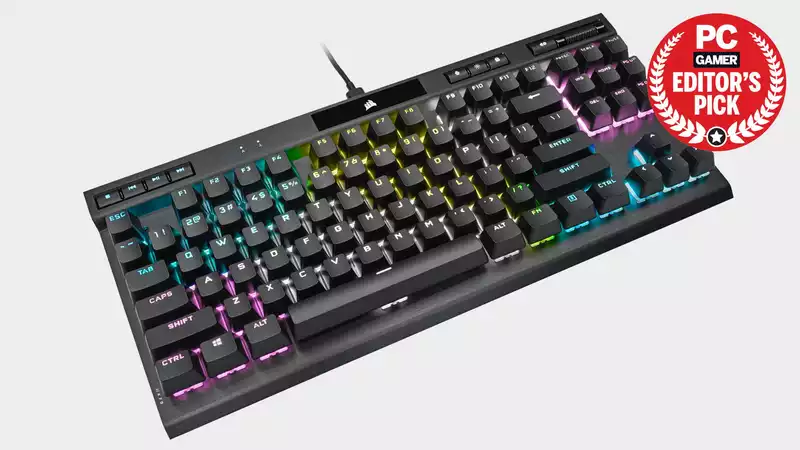The Corsair K70 RGB TKL Champion series may be the keyboard that finally lets us understand what a tenkeyless keyboard has to offer. I have reviewed 65 percent keyboards and enjoyed their novelty, but found that at the end of the day I like a few extra keys, and the TKL board is the logical keyboard that falls somewhere between a hard-to-use 65 percent keyboard and a full-size keyboard.
But first let's talk about what sets Corsair's Champion series apart from other competitive mechanical gaming keyboards: the tournament switches. This is a small switch on the back of the keyboard that disables macros and resets the keyboard to its default factory state.
This switch allows tournament judges to quickly see that you're not playing pranks with your macros; I wish it came with a cover for the keyboard like the ROG Falchion did.
The design is similar to the full-size K70 RGB Mk. 2, and Corsair has been making essentially the same keyboard since 2013. A black matte finish and aluminum frame are present, along with PBT double-shot backlight-enabled keycaps. The main difference is the lack of 10 number keys on the right side, but I found this to be less of an issue than I expected.
I am not a good typist. When I'm sufficiently caffeinated, I typically log 80-85 wpm; on the K70, according to my usual typing tests, I logged about 87 wpm.
The PBT double-shot keycaps have a good feel and are a little easier to apply when tip-tapping; the Cherry MX Red mechanical switches are satisfying linear switches and always produce great typing; the K70's Cherry MX Red keycaps have a good feel and are a little easier to apply when tip-tapping.
Corsair sent me a red, white, and blue replacement PBT keycap kit to spruce up the K70's appearance. The replacement kits come with silicone O-rings that soften the sound and feel of the keys. The kits cost $30 apiece, but honestly, you could spend your money on something much worse.
The K70 boasts 8,000Hz hyperpolling (double that of the Corsair K100), but in the few games I actually played with Call of Duty Warzone and Apex Legends, I didn't notice a huge difference. 8,000Hz hyperpolling does what The short answer is that it reduces the time it takes for keystrokes to be detected, resulting in faster on-screen movement. In fact, hyperpolling seems to be one of those things where the numbers are impressive but the real-world benefits are debatable.
Through the ICUE software, a dizzying number of customization options are accessible for both macro settings and RGB lighting. Different RGB effects can be selected for individual keys or for different parts of the keys. I chose to set up profiles for the WASD keys and for the lighting of keys 1-6. Coupled with the colorful replacement keycaps, it feels just like my K70 keyboard. It takes some time to master the software, but it's worth it.
One thing I noticed is that you can toggle off the Win key and Alt+Tab from within the performance options. This is great for those of us who tend to inadvertently exit the game with Alt+Tab when the game starts to heat up. However, I wonder why this does not happen automatically when the Tournament switch is pressed. Setting up a tournament is a matter of avoiding accidental clicks.
The Corsair K70 RGB TKL Champion Series is a great keyboard. It might even convert me to TKL. However, I find the $140 price a little too high, considering that you can get a full-size version of this keyboard for an extra $20-30 if you don't mind 8,000Hz hyperpolling and tournament switches.
That said, the K70 Champion remains a hell of a keyboard for both competitive and casual gamers.


Comments